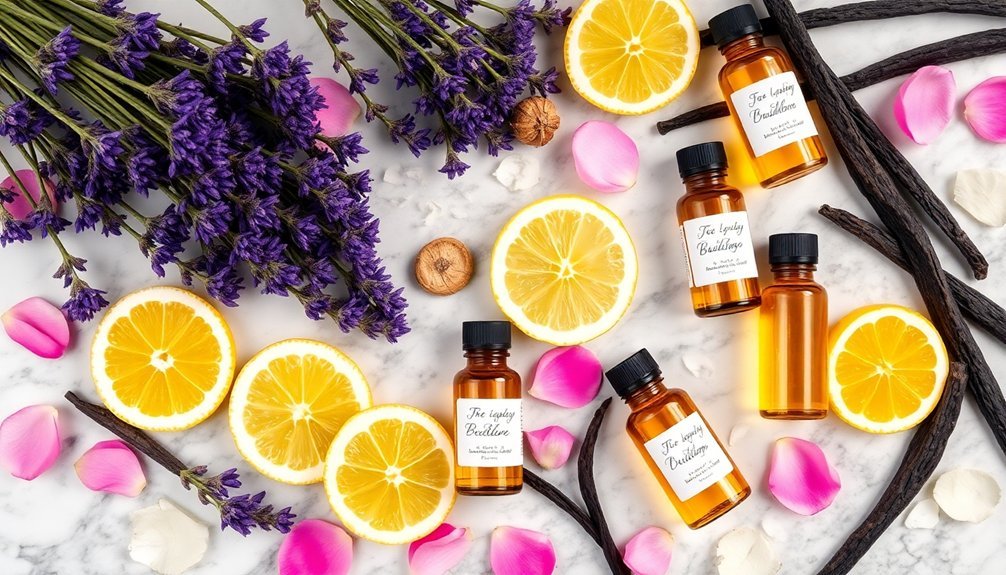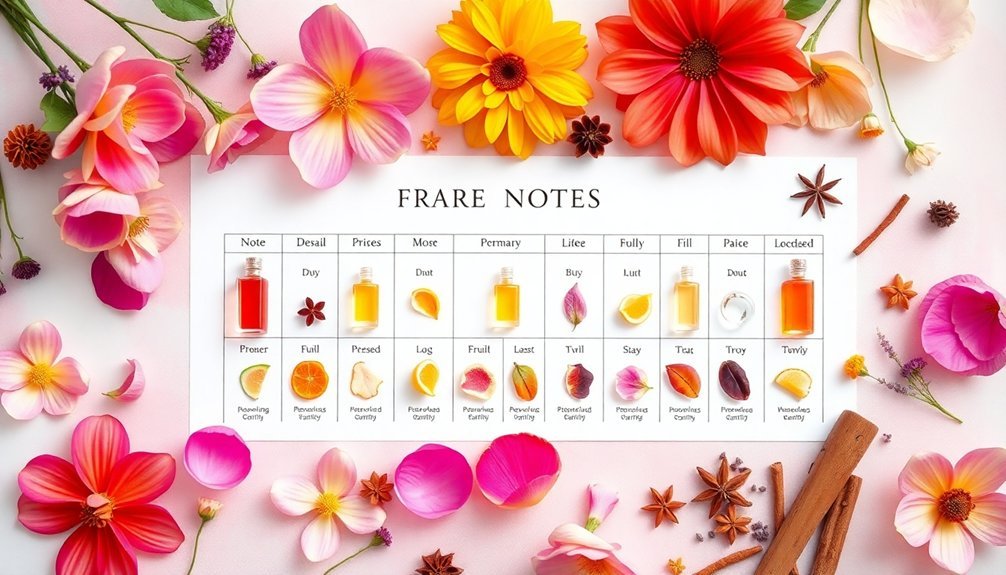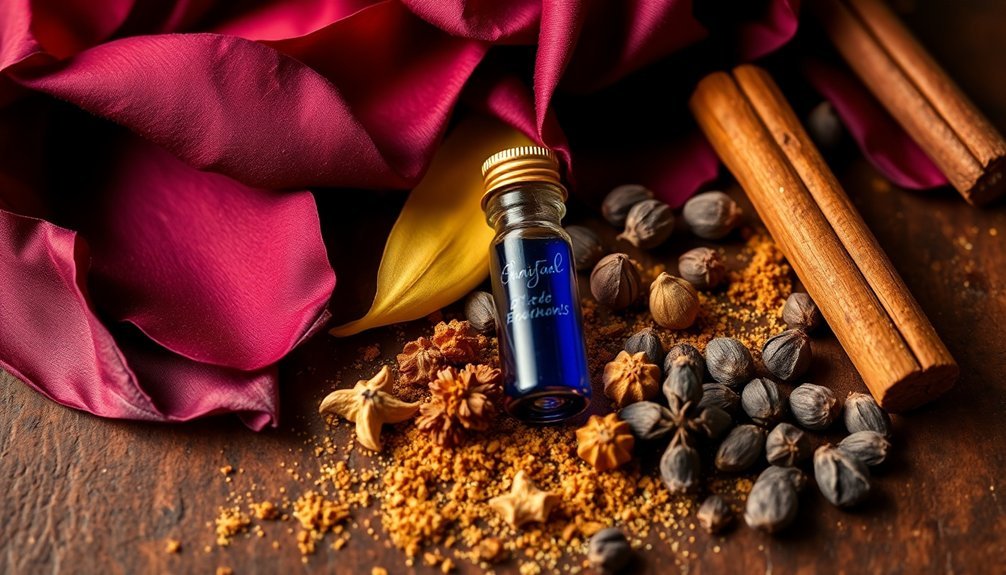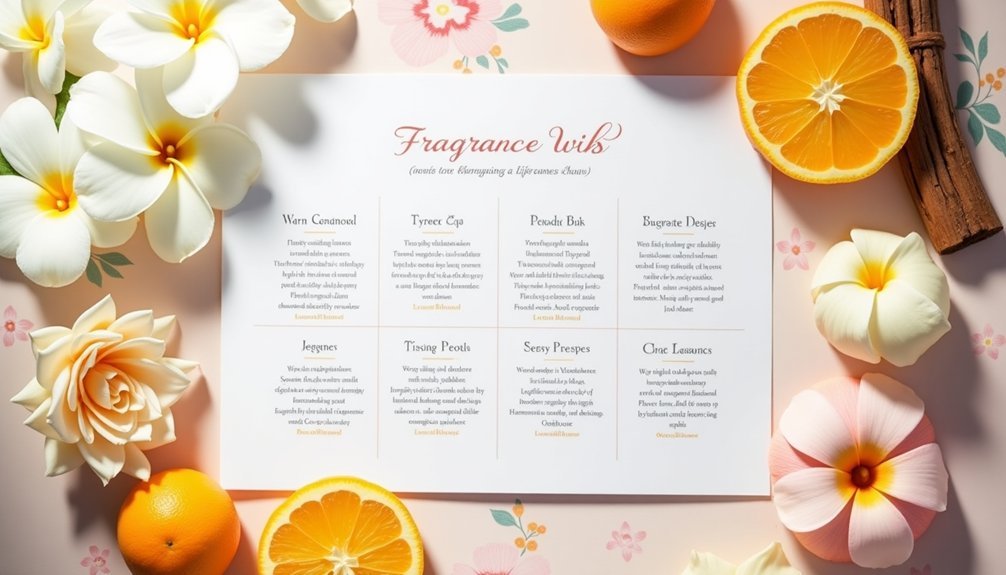Fragrance notes mix well when you follow key pairing principles across scent families. You'll find success combining florals with woody notes (like jasmine and sandalwood), citrus with aromatics (orange and rosemary), or sweet with spicy notes (vanilla and cinnamon). The standard blending ratio uses 30% top notes, 50% middle notes, and 20% base notes. For seasonal combinations, pair fresh citrus-herbal blends in summer and warm spicy-woody notes in winter. The complete fragrance wheel holds even more dynamic possibilities for your perfect scent.
Understanding the Basics of Fragrance Note Combinations

When you're delving into the world of fragrances, understanding note combinations is crucial for creating balanced and appealing scents. The key lies in knowing how different fragrance families interact and complement each other on the fragrance wheel.
Complementary notes, which sit opposite each other on the wheel, create dynamic contrasts – like fresh citrus paired with warm vanilla.
Meanwhile, kindred notes that are considered similar or adjacent enhance complexity, such as combining jasmine with rose for a layered effect.
To achieve harmony in your fragrance combinations, pay attention to the intensity of each note.
You'll want to balance lighter top notes with richer base notes. This layering technique guarantees your scent maintains its character throughout wear while allowing you to craft unique, personalized fragrances that suit your style.
Essential Categories on the Fragrance Wheel
You'll find that adjacent families on the fragrance wheel, such as Floral and Oriental, share complementary characteristics that make them naturally blend well together.
Understanding these neighboring relationships helps you create harmonious scent combinations, whether you're layering perfumes or selecting a signature fragrance with multiple notes.
For bold and dramatic effects, you can experiment with pairing opposite fragrance groups on the wheel, like Fresh with Oriental or Woody with Floral, to create intriguing contrasts that capture attention.
Understanding Adjacent Scent Families
Understanding adjacent scent families on the fragrance wheel opens up a world of possibilities for creating harmonious fragrance combinations.
When you're exploring scents, you'll find that neighboring fragrance families share common characteristics that blend naturally together, making them perfect partners in your fragrance journey.
You'll discover that kindred notes from adjacent families, like Floral and Fruity, work seamlessly together because they share similar olfactory qualities.
While adjacent scent families create familiar and balanced blends, you can also experiment with complementary notes from opposite sides of the fragrance wheel to develop more complex and intriguing combinations.
This knowledge helps you select fragrances that match your preferences, whether you're drawn to the fresh-floral shift or the warm oriental-woody connection.
Pairing Opposite Fragrance Groups
Taking your fragrance exploration to the next level means mastering the art of pairing opposite scent families. When you combine opposite fragrance groups, you'll create complex and balanced perfumes that tell a unique olfactory story. Fresh scents paired with Oriental fragrances create an exciting contrast between cool, airy notes and warm, spicy undertones.
- Combine Aromatic notes with Fruity notes to achieve a vibrant blend that's both herbal and sweet.
- Mix Floral with Woody elements to create depth and intrigue in your fragrance profile.
- Layer Green notes with Amber accords to capture the essence of nature while maintaining warmth.
These strategic combinations work because they create tension between contrasting elements, resulting in sophisticated fragrances that evolve beautifully on your skin throughout the day.
Complementary Note Pairings Across Families

Creating enchanting fragrances relies heavily on the art of pairing complementary notes from different fragrance families. You'll find that certain combinations create stunning harmony when properly balanced. Let's explore these magical pairings that'll transform your fragrance experience.
| Base Note | Complementary Note | Effect |
|---|---|---|
| Floral (Jasmine) | Woody (Sandalwood) | Romantic & Grounding |
| Citrus (Orange) | Aromatic (Rosemary) | Fresh & Sophisticated |
| Sweet (Vanilla) | Spicy (Cinnamon) | Warm & Comforting |
| Aquatic (Sea Spray) | Earthy (Vetiver) | Natural & Balanced |
| Floral (Peony) | Green (Basil) | Vibrant & Energizing |
These complementary note pairings showcase how opposite fragrance families can work together to create complex, well-rounded scents. You'll notice that each combination offers a unique sensory experience, from grounding woody notes to uplifting florals.
Warm and Spicy Note Blending Guide
When you're creating warm and spicy fragrances, you'll find amber and vanilla naturally complement each other, forming a rich, sweet foundation that supports additional layers.
Oriental combinations work best when you balance intense spices like cinnamon and cardamom with softer elements such as sandalwood or jasmine.
To master spice note pairings, remember that warming spices like clove and nutmeg should be used sparingly and can be tempered with citrus or aromatic notes for a more balanced composition.
Amber With Vanilla Blends
The luxurious pairing of amber with vanilla stands as one of perfumery's most beloved combinations, offering a timeless blend of warmth and comfort.
You'll find this duo frequently anchoring oriental fragrances, where their rich base notes create a lasting impression throughout the day. When these warm notes combine, they produce a complex aroma that's both sophisticated and inviting.
Here's why amber and vanilla work so perfectly together:
- They share complementary characteristics – amber's resinous quality enhances vanilla's creamy sweetness.
- Their strong base notes guarantee your fragrance maintains its presence for hours.
- The combination creates a versatile scent that's particularly effective in evening wear and winter fragrances.
These notes blend seamlessly to evoke feelings of nostalgia while maintaining a modern, sensual appeal that suits various fragrance preferences.
Spice Note Pairing Rules
Mastering spice note combinations requires understanding their natural affinities and potential clashes in fragrance composition. You'll find that warm and spicy notes pair exceptionally well with sweet notes, creating inviting and cozy scents. For perfect balance, combine your spicy notes with complementary elements.
| Spice Combination | Effect |
|---|---|
| Spices + Sweet Notes | Creates cozy blend with vanilla, caramel |
| Spices + Citrus | Adds invigorating contrast, complexity |
| Spices + Florals | Develops elegant depth with jasmine, orange blossom |
When crafting your fragrance composition, start with a solid base of amber or musk to anchor the spicy notes. Layer warm notes like cinnamon and nutmeg with woody elements such as sandalwood for a grounding effect. Remember that floral notes can add sophistication to your spicy blend while maintaining balance.
Oriental Fragrance Combinations
Creating luxurious oriental fragrances starts with understanding their signature warm and spicy character. When you're blending rich scents, it's crucial to balance sweet and warm base notes with complementary elements that enhance their opulent nature.
To create a well-rounded oriental fragrance, follow these key combinations:
- Layer vanilla and cardamom with jasmine or orange blossom floral elements for a sensual, evening-appropriate blend.
- Add woody notes like sandalwood or patchouli to provide earthiness and depth that balances the sweetness.
- Incorporate spicy elements such as anise or cloves to create vibrancy and complexity.
The luxurious aroma of oriental fragrances comes from carefully combining these components.
You'll find that warm base notes, soft florals, and deep woods work together to create an inviting and memorable scent profile.
Fresh and Citrus Note Mixing Chart
Fragrant citrus notes serve as versatile building blocks for creating dynamic and uplifting scents. You'll find that these invigorating fragrances work exceptionally well when paired with complementary notes to create balanced, revitalizing combinations. Here's a practical chart showing how to mix fresh scent elements:
| Base Note | Complementary Note | Result |
|---|---|---|
| Lemon | Green notes | Crisp, herbal |
| Bergamot | Floral elements | Soft, elegant |
| Mandarin | Aquatic notes | Clean, breezy |
| Orange | Jasmine | Sweet, balanced |
| Grapefruit | Mint | Zesty, fresh |
When you're creating your signature blend, remember that citrus notes typically work best as top notes, providing an immediate burst of vitality. They'll enhance your fragrance's opening while creating a perfect foundation for deeper, more complex scent combinations.
Floral Note Compatibility Matrix

While floral notes form the heart of many beloved fragrances, their true potential emerges through strategic combinations with other scent families.
Understanding floral note compatibility helps you create perfectly balanced scents that suit any occasion. You'll find that florals complement various fragrance families, from fresh citrus to rich orientals.
- Pair floral notes with fruits (peach, berry) or citrus (bergamot, lemon) for bright, energetic daytime scents.
- Blend florals with green notes (basil, mint) or woods (sandalwood, cedar) to achieve sophisticated, balanced fragrances.
- Mix floral notes with warm orientals (vanilla, amber) for luxurious evening scents that exude sensuality.
This versatile compatibility matrix shows why floral notes remain essential in perfumery, offering endless possibilities for creating unique and enchanting fragrances.
Woody Note Pairing Recommendations
Three fundamental qualities make woody notes exceptional fragrance anchors: their versatility, depth, and grounding effect.
When you're creating your signature scent, you'll find that woody notes complement each other nicely with various fragrance families.
For a balanced earthy fragrance, pair woody notes with aromatic elements like lavender and rosemary. You can add brightness to these deep base notes by incorporating citrus scents such as bergamot or lemon.
To create sophisticated complexity, combine them with floral elements like jasmine or rose. If you're seeking warmth and sweetness, try mixing woody notes with gourmand notes like vanilla or caramel.
For an exotic evening fragrance, incorporate spices such as cinnamon or cardamom, which enhance the wood's natural warmth and create an inviting atmosphere.
Oriental Note Blending Possibilities

Moving from woody foundations to the domain of oriental fragrances opens up a world of rich, sensual possibilities.
You'll find that oriental fragrances blend beautifully with warm, sweet, and spicy fragrance notes like vanilla, cinnamon, and cardamom. For maximum impact and longevity, incorporate base notes of myrrh and benzoin to anchor your blend.
Consider these powerful oriental combinations:
- Floral oriental pairings with jasmine and orange blossom create an opulent, deep character
- Woody oriental blends featuring sandalwood and patchouli add earthy comfort
- Gourmand elements like caramel and chocolate transform the scent into a decadent experience
These combinations showcase the versatility of oriental fragrances, allowing you to create complex, long-lasting scents that evolve beautifully throughout wear.
Creating Balanced Top Note Combinations
You'll find that pairing citrus top notes like bergamot or lemon with floral elements such as jasmine creates an uplifting yet sophisticated opening to your fragrance.
To add more depth and intrigue, you can blend spicy notes like cardamom with fresh citrus components, resulting in a complex and engaging initial impression.
These balanced combinations work together to form a memorable and harmonious introduction that sets the tone for the rest of the fragrance's development.
Citrus-Floral Top Note Pairings
Creating balanced citrus-floral top note combinations requires a thoughtful approach to harmony and contrast.
When you combine citrus and floral notes in your fragrance, you'll achieve a vibrant, uplifting scent that balances zesty brightness with sweet sophistication.
Here's how to pair these notes effectively:
- Mix bergamot or lemon with jasmine and rose to create an invigorating blend that highlights the revitalizing qualities of both note families.
- Pair orange blossom and peony with mandarin and grapefruit for a harmonious combination that creates an energizing yet romantic profile.
- Balance the intensity of your citrus notes against softer floral elements to guarantee neither dominates the overall fragrance composition.
You'll find that these citrus-floral pairings create well-rounded scents that appeal to a wide range of preferences while maintaining their sophisticated character.
Spicy-Fresh Note Combinations
The art of blending spicy and fresh notes demands a delicate balance between warmth and energy. You'll find that spicy notes like cardamom, ginger, and cinnamon pair exceptionally well with fresh citrus elements such as bergamot, lemon, and mandarin to create an invigorating scent profile.
For added complexity, try incorporating herbal crispness through green notes like basil or mint. These combinations work particularly well in aromatic fougère fragrances, where lavender's soothing qualities complement spicy undertones.
If you're looking for a unique twist, consider pairing spicy notes with aquatic scents – think sea spray or cucumber. This unexpected combination delivers a versatile fragrance that's both warming and revitalizing.
The key is to maintain equilibrium between these contrasting elements, ensuring neither overwhelms the other.
Heart Note Mixing Strategies

Successfully mixing heart notes requires understanding their role as the fragrance's core personality. When creating your scent experience, consider how different notes interact to form a balanced and harmonious blend.
You'll find that working within the same fragrance family or mixing complementary notes yields the most cohesive results.
Three essential strategies for mixing heart notes:
- Pair bright floral perfumes like jasmine with fruity notes such as peach for an uplifting combination.
- Layer herbal heart notes (lavender, rosemary) with soft florals like peony to create depth.
- Combine different variations of the same floral note (bulgarian and damask rose) to enhance complexity.
For a more adventurous blend, try mixing your floral heart notes with spicy elements like cardamom or nutmeg to add warmth and intrigue.
Base Note Harmony Guidelines
Since base notes form the lasting impression of your fragrance, mastering their harmony requires careful consideration of both compatibility and longevity.
To create depth and longevity in your scent, pair similar ingredients like vanilla with other sweet base notes such as benzoin. This creates a warm, unified foundation that'll last 8+ hours.
You'll want to harmonize your base notes with complementary notes to achieve a balanced fragrance profile.
Try combining deep musks with fresh, ozonic elements for an intriguing contrast.
When selecting base notes, verify they shift smoothly with your middle and top notes.
Always test the combination on your skin, as personal chemistry notably impacts how the notes develop.
Classic base notes like sandalwood, vanilla, and musk provide excellent starting points for your fragrance foundation.
Seasonal Fragrance Note Combinations

Following nature's rhythm, fragrance combinations shift throughout the year to match each season's distinct character.
You'll find that seasonal fragrances adapt to both weather and mood, with citrus scents dominating summer while warm notes embrace winter's chill.
Spring and summer fragrance notes lean towards brightness and liveliness. You can blend floral notes like jasmine with green accords for spring, or pair citrus with aquatic notes for summer freshness.
Fall and winter call for deeper combinations, where spicy notes merge with woody and resinous elements.
- Brighten spring/summer scents by combining:
- Citrus + Herbs
- Light Florals + Green Notes
- Tropical Fruits + Marine Accords
For autumn and winter, focus on comfort through warm notes, pairing vanilla with amber, or cinnamon with dark woods.
Professional Blending Ratios and Proportions
Creating professional fragrance blends requires understanding key ratios that perfumers have refined over centuries of experimentation.
The standard professional ratio for a balanced scent profile is 30% top notes, 50% middle notes, and 20% base notes.
When mixing fragrance notes, you'll want to take into account both harmonious and complementary blends.
For harmonious combinations, pair similar scent families together, like floral with floral. For complementary blends, combine contrasting families using a 60/40 ratio, with the dominant scent taking the larger share.
Always account for different evaporation rates when crafting blended fragrances.
Start with small test samples and let them mature for several days. You can then adjust the proportions until you achieve your desired scent, remembering that top notes fade quickly while base notes persist longer.
Frequently Asked Questions
What Perfume Notes Go Well Together?
You'll find that floral notes like jasmine blend perfectly with rose, while woody scents complement warm spices. Citrus pairs well with green notes, and gourmand notes mix beautifully with fruits for balanced fragrances.
What Fragrance Blends Well Together?
You'll find success blending citrus with vanilla, jasmine with rose, sandalwood with cardamom, caramel with apple, or lavender with basil. These combinations create balanced, harmonious fragrances that complement each other perfectly.
What Is the 30 50 20 Rule for Perfume?
You'll create a balanced perfume by following the 30-50-20 rule: use 30% top notes for initial impact, 50% middle notes for the core scent, and 20% base notes for lasting depth.
What Fragrances Mix Well?
You'll find citrus blends well with florals, woody notes pair perfectly with oriental scents, fruity notes complement floral hearts, aromatics mix with greens, and gourmand notes harmonize with soft florals for balanced fragrances.
In Summary
Now you're equipped to create enchanting fragrance combinations that reflect your personal style. Remember to start with complementary notes from the fragrance wheel, balance your ratios carefully, and trust your nose. Don't be afraid to experiment with seasonal blends and mix across fragrance families. Whether you're crafting a signature scent or exploring aromatherapy, these mixing principles will guide your aromatic journey.





Leave a Reply